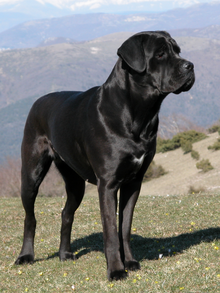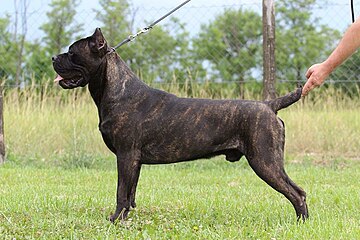Cane Corso
| Cane Corso | |||||||||||||||||
|---|---|---|---|---|---|---|---|---|---|---|---|---|---|---|---|---|---|
 | |||||||||||||||||
| Other names |
| ||||||||||||||||
| Origin | Italy | ||||||||||||||||
| |||||||||||||||||
| |||||||||||||||||
| Dog ( domestic dog ) | |||||||||||||||||
The Cane Corso
History
According to the breed standard of the
In the period 2011–2019 the number of annual registrations in Italy was in the range of 3000–4250.[8]
Characteristics
The Cane Corso is a large dog of
The head is large, slightly over one third of the height at the withers in length, with a well-defined stop. The top of the cranium is flat and slightly convergent to the muzzle. The eyes are oval in shape, and set well apart. The iris of the eye should be as dark as possible.[2]
The coat is short, dense and lustrous. It may be black, various shades of grey (lead-grey, light grey or slate-grey) or fawn (dark fawn, light fawn, or stag red), or dark wheaten ('fromentino'); it may be
The Cane Corso is genetically pre-disposed to
In 2017 a study of 232 Cane Corso dogs from 25 countries found an average life span of 9.3 years, varying with different coat colours. The longest-lived were black brindle (10.3 years), followed by: brindle (10.1 years); grey brindle (9.8 years); black, fawn and grey (all 9.0 years); and dogs of other colours (8.1 years).[10] A study of dogs in the United Kingdom, published in 2024, found an average life span for the breed of 8.1 years overall.[11]
Use
The Cane Corso is usually kept as a
It is subject to a
-
Grey brindle
-
Brown brindle
-
Black brindle
-
Fawn
Notes
- ^ Italian: [ˈkaːne ˈkɔrso], plural: Cani Corsi
References
- ^ a b c d e f FCI-Standard N° 343: Cane Corso Italiano (Italian Cane Corso). Fédération Cynologique Internationale. Archived 13 August 2021.
- ^ a b c Cane Corso (in Italian). Ente Nazionale della Cinofilia Italiana. Accessed August 2021.
- ^ . (subscription required).
- ISBN 9788841854068.
- ^ Cane corso italiano (in Italian). Società Amatori Cane Corso. Archived 21 May 2021.
- ^ FCI breeds nomenclature: Cane Corso Italiano (343). Fédération Cynologique Internationale. Archived 5 July 2020.
- ^ a b Get to Know the Cane Corso. The American Kennel Club. Archived 19 May 2015.
- ^ a b Cane Corso (in Italian). Ente Nazionale della Cinofilia Italiana. Accessed August 2021.
- ISBN 9781482241419.
- .
- .
- ^ CAL (Certificato di attitudine al lavoro) (in Italian). Società Amatori Cane Corso. Archived 23 August 2021.




